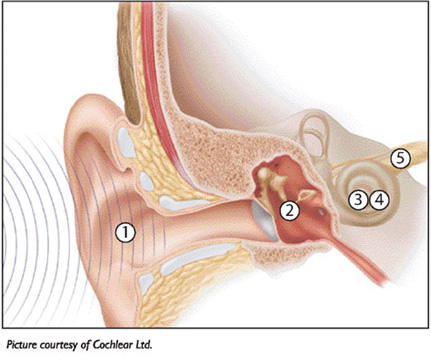How Hearing Works
The ear has three parts: the external ear (or pinna and ear canal), the middle ear and the inner ear. Each part of the ear has a role in hearing.
- The external ear gathers sound waves and transmits them to the ear drum. The eardrum is a membrane between the outer and middle ear. The sounds waves produce vibrations of the eardrum which are then transmitted to the first bone of the middle ear, the malleus (hammer). The sound waves are amplified as they are passed from the eardrum and malleus to the next two bones of hearing, the incus (anvil) and stapes (stirrup).
- Once the sound waves have reached the stapes sound has been converted from an air pressure wave to a mechanical force. The stapes rests on a thin membrane separating the middle ear from the fluid-filled inner ear. As the stapes vibrates, sound waves are transformed into fluid waves in the inner ear.
- The inner ear contains fragile membranes, hair cells and nerve endings. The fluid waves and movement of the membranes stimulate the hair cells, which then activate the nerve endings. Finally the electrical signal of hearing travels along the cochlear (hearing) nerve to the brain and the sound is “heard.”

- Sound is transmitted as sound waves from the environment. The sound waves are gathered by the outer ear and sent down the ear canal to the eardrum.
- The sound waves cause the eardrum to vibrate which sets the three tiny bones in the middle ear into motion.
- The motion of the bones causes the fluid in the inner ear or cochlea to move.
- The movement of the inner ear fluid causes the hair cells in the cochlea to bend. The hair cells change the movement into electrical pulses.
- These electrical impulses are transmitted to the hearing (auditory) nerve and up to the brain where they are interpreted as sound.
- Acoustic Neuroma
- Bone-Anchored Hearing Aids
- Cochlear Implants
- Chronic Ear Infections
- Do I Really Need Two Hearing Aids?
- Ear Tubes
- Facial Nerve Weakness
- How Hearing Works
- Hearing Tests
- Tips for Better Hearing
- Meniere's Disease
- Otosclerosis
- Perforations of the Eardrum
- Tinnitus
- Types of Hearing Impairment
- Hearing Aids
